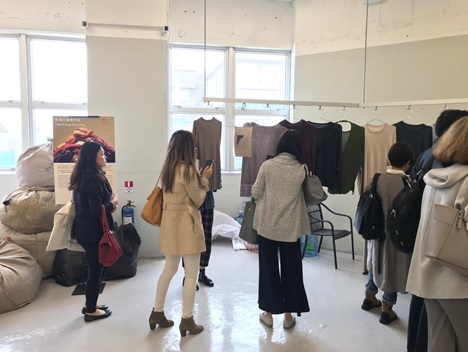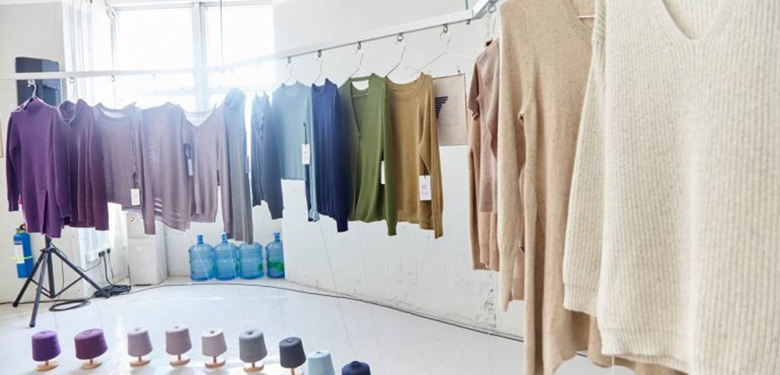The Hong Kong hub: a showcase for innovation
Hong Kong is a central sourcing hub for fashion brands, and as such, has a unique advantage as a place where innovation can be showcased to the rest of the world. However, the high cost of land associated with limited space in Hong Kong offers unique challenges in terms of waste processing.
In September 2018, Novetex Textiles Limited opened Hong Kong’s first upcycling mill, a 19,000 sq ft factory in Tai Po. The project was launched in collaboration with The Hong Kong Research Institute of Textiles and Apparel (HKRITA), supported by the Innovation and Technology Commission. Novetex offers an identifiable opportunity for brands to reconsider the traditional linear model by which products are produced, consumed and then disposed of. This partnership offers brands with a unique opportunity to reinvent their supply chains by helping factories close the loop on textile waste in the process of manufacturing a garment.
The factory has attracted a number of visits from local media, consumers, brands and government representatives — including the chief executive of the HKSAR Environmental Protection Department.
Opportunity for supply chain transformation
The upcycling mill was devised by Novetex and HKRITA Chief Executives to help factories recycle textile waste in the manufacturing process. Through Novetex’s mechanical sorting operations, supply chain waste from cut and sew operations, brand inventory and end of use consumer garments can be repurposed into sterilized recycled yarn, providing brands with a solution to their discarded waste and offering a closed loop avenue for fashion supply chains. ‘Closing the loop’ on the life of factory products is also economical, explains Chief Operating Officer at Novetex, Mr. Max Ng. When compared to use of costly virgin cotton or wool, recycled yarn can generate savings from 5-15%. It can also greatly lower CO2 emissions, by reducing the farming, harvesting and extraction, needed to manufacture the virgin spun yarn, as well as the emissions produced at the product disposal stage.
2018 saw great progress in closed-loop garment manufacturing with Novetex’s first shipment of upcycled yarn to Swedish clothing retailer H&M. With a pledge to push upcycling technology further, H&M is working with Novetex to make their technology more widely available.

Image 1: Novetex offers brands an opportunity to exit the linear model of garment production by helping factories close the loop on textile waste in the manufacturing process
Industry collaboration for a robust long-term solution
Novetex believes the upcycling mill is proof that Hong Kong has the tools to prevent factory waste from entering landfill. The HKSAR Government is encouraging Novetex to expand operations and handle more waste by offering incentives such as increased access to land. Currently upcycling around one ton of textile waste per day, the Novetex mill has additional upcycling productions lines currently under construction with the aim to triple production to three tonnes of upcycled yarn each day.
While there are only a handful of brands currently focused on long term financial success with environmental and social responsibility, Ng points out that the conversation amongst brands is growing, and 2019 is set to be a big year for circular fashion. Leaders like Novetex are quickly expanding to meet the difficult challenges in sustainability that brands will face in the near future. Ng believes collaboration will keep Novetex at the forefront of technological solutions for a more responsible fashion industry.
For more information on tools and disruptive technologies in garment supply chains, contact kelly.cooper@elevatelimited.com.
References
- Business of Fashion. How Can Fashion Embrace the Circular Economy? (2018). Available online at: https://www.businessoffashion.com/articles/voices/how-can-fashion-embrace-the-circular-economy
- Boston Consulting Group (BCG). Sustainability Is Good Business for Fashion (2018). Available online at: https://www.bcg.com/publications/2018/sustainability-good-business-fashion.aspx
Recommended reading
- ELEVATE Limited. (2018). Rise of responsible brands and consumers in the fashion industry. Available online at: http://www.elevatelimited.com/insights/rise-of-responsible-brands-and-consumers-in-the-fashion-industry/
- Ellen MacArthur Foundation. (2017). A new textiles economy: Redesigning fashion’s future. [pdf] Available online at: https://www.ellenmacarthurfoundation.org/assets/downloads/A-New-Textiles-Economy_Full-Report_Updated_1-12-17.pdf
- Ellen MacArthur Foundation. (2016). The new plastics economy: Rethinking the future of plastics. [pdf] Available online at: https://www.ellenmacarthurfoundation.org
